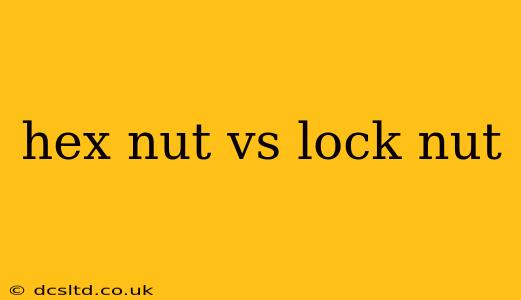Nuts and bolts are fundamental elements in countless applications, from simple household repairs to complex engineering projects. While both hex nuts and lock nuts serve to fasten bolts, they differ significantly in their design and purpose. This comprehensive guide will explore the key distinctions between hex nuts and lock nuts, clarifying their functionalities and helping you choose the right fastener for your specific needs.
What is a Hex Nut?
A hex nut, also known as a hexagonal nut, is the most common type of nut. Its defining feature is its hexagonal shape, which allows for easy tightening and loosening using a wrench. The six sides provide ample grip, facilitating secure fastening without damaging the nut. Hex nuts are incredibly versatile and used across a wide range of applications where simple and reliable fastening is required. They are typically made from materials like steel, brass, or stainless steel, offering varying degrees of strength and corrosion resistance.
What is a Lock Nut?
Unlike standard hex nuts, lock nuts are designed to prevent loosening under vibration or stress. They incorporate various mechanisms to maintain a secure grip on the bolt, even in dynamic environments. This crucial feature prevents potentially dangerous or disruptive situations caused by loose fasteners. There are several types of lock nuts, each employing a unique locking mechanism, including:
- Nylon Insert Lock Nuts: These nuts contain a nylon insert that deforms slightly upon tightening, creating friction that prevents loosening.
- All-Metal Lock Nuts: These nuts utilize various mechanical designs, such as a prevailing torque feature, to resist loosening. Examples include castle nuts and wedge-lock nuts.
- Prevailing Torque Nuts: These nuts are designed with a slightly larger diameter than standard nuts, providing a higher clamping force that resists loosening.
Hex Nut vs. Lock Nut: Key Differences
The primary difference lies in their function:
| Feature | Hex Nut | Lock Nut |
|---|---|---|
| Primary Function | Fastening | Fastening and Preventing Loosening |
| Design | Standard hexagonal shape | Various designs with locking features |
| Vibration Resistance | Low | High |
| Applications | General fastening applications | Applications requiring vibration resistance |
| Cost | Generally less expensive | Generally more expensive |
What are the applications of hex nuts?
Hex nuts are the workhorse of the fastener world. Their widespread use stems from their simplicity, affordability, and effectiveness in a wide variety of applications. Some examples include:
- Furniture assembly: Securing chair legs, table tops, and other components.
- Automotive applications: Used in many automotive components, although often replaced with stronger fasteners in critical areas.
- Construction: Fastening structural elements, although typically with more specialized nuts for safety reasons.
- General Mechanical Applications: A vast range of machinery and equipment utilize standard hex nuts.
What are the applications of lock nuts?
Lock nuts are essential where fastener security is critical. Their application is predominantly focused on situations where vibration or dynamic loads are present. Examples include:
- Automotive applications: Securing wheels, brake components, and other parts subject to significant vibration.
- Aerospace applications: Critical components requiring absolute security in high-stress environments.
- Machinery and equipment: Securing components that experience constant vibration or movement.
Which type of nut should I use?
The choice between a hex nut and a lock nut depends entirely on the application. If a simple, reliable fastening solution is needed in a static environment, a hex nut is sufficient. However, if the application involves vibration, movement, or requires high reliability to prevent loosening, a lock nut is the better choice. Always consider the potential consequences of a loose fastener before making a selection.
What types of lock nuts are available?
As mentioned earlier, several types of lock nuts exist, each with its specific locking mechanism. The optimal type will depend on the application's specific needs regarding load, vibration, and material compatibility. Detailed specifications for each nut type can often be found in engineering handbooks or manufacturer's specifications.
How do I choose the right lock nut?
Selecting the appropriate lock nut requires careful consideration of several factors, including:
- The level of vibration or dynamic load: Higher vibration levels demand a more robust locking mechanism.
- The material of the nut and bolt: Compatibility is essential for optimal performance and corrosion resistance.
- The required torque: Ensure the selected lock nut can withstand the necessary torque without damage.
- Environmental conditions: Consider factors like temperature and humidity when selecting a lock nut material.
By understanding the nuances of hex nuts and lock nuts, you can make informed decisions when selecting the right fasteners for your projects, ensuring safety and reliability. Remember to always consult relevant engineering standards and manufacturer's specifications for critical applications.
